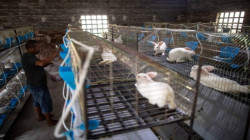Earth's deadliest enemy: Zoonotic diseases pose as big a threat to humanity as nuclear war

In a report published in DailyMail, the researcher explains his point of view.
“Ecologists at University College London (UCL) report that, since 1940, 335 new and potentially fatal diseases have emerged globally, of which more than 200 are zoonoses — viruses, bacteria, parasites, fungi and prions that occur naturally in wild and domesticated animals but which are turning up in humans.”
They include some of the most deadly diseases ever encountered: HIV, of course, Ebola, Lassa Fever, Marburg and Simian foamy virus in Africa; Sars and now Covid-19 in China; Chagas, Machupo and Hantavirus in Latin America; Hendra in Australia, and Mers in Saudi Arabia.
Almost all have spread internationally and there are vaccines for only one or two. In addition, three new deadly pandemic influenza A strains have surfaced since 1957, and bird and swine flus have crossed to humans. He wrote.
Any one of them can mutate and potentially devastate human populations.
So how and why are these zoonoses making the transition? He asked.
Over centuries, the close proximity of humans and the animals kept for food in primitive dwellings was a factor — and remains so in parts of Asia, especially when it comes to poultry.
Today, however, zoonoses are increasingly linked to deforestation, land clearance, the encroachment of urban dwellings into previously wild areas, and the hunting and sale of animals for food in markets.
Others, like Dengue and Chikungunya, both mosquito-borne, are spreading fast as the world warms because of climate change, allowing disease-carrying insects to flourish in new areas. Some years ago I travelled to the heart of the Congo basin rainforest in Gabon where there had been an outbreak of Ebola — named after a river in the Congo — several years earlier. He added
The Ebola outbreak was over but nothing would be the same again for the community, he said. He, like others, had fled the village when the disease struck, but it had killed two of his family and many of his friends.
There was nothing to prove conclusively that environmental change was the cause of the Ebola outbreak, but researchers have since studied many other incidents of this and other diseases and found almost all have started in places where deforestation had recently taken place. He explains.
It is thought that disrupting the normal forest habitat of bats, often a reservoir of viruses that may ultimately endanger humans, forces them to find other places to live, presenting new opportunities for primates to become infected — and the viruses can then be passed via primates to humans.
The growing demand for bushmeat — African wild animals killed for food — and the popularity of ‘wet markets’ in Asia and elsewhere selling fresh meat, often from exotic animals, is another factor in the growth of zoo- notic illnesses.
According to researchers at Brown University in the U.S., the past three decades has seen an increasing number of infectious disease outbreaks from an increasing number of sources. Some are unexpected.
In 1997, fires set by palm oil companies to clear vast tracts of Indonesian forests for plantations, killed thousands of orang-utans and other animals.
Months later, a new disease broke out near a town called Sungai Nipah hundreds of miles away in Malaysia, killing hundreds of people.
It took scientists years to establish that fruit bats, which usually foraged on trees in the Indonesian forests, had been forced by the fires to seek new food sources.
Some had flown to Sungai Nipah where they had roosted in the fruit trees and dropped pieces of half-eaten fruit into the pig pens below.
The pigs ate the fruit, which was contaminated by bat urine, and then passed the disease, now called Nipah, to humans (the movie Contagion is modelled on the evolution of Nipah).
Not all diseases that have spilled over from animals to humans in the past 50 years come from tropical hotspot areas, however. Lyme disease, caused by tick bites, has become an epidemic in the northern U.S. because developers are building houses in recently-cleared forest land on the edge of cities.
Bats that colonize Australian suburbs can infect horses with a disease called Hendra and they can then pass it on to humans.
In the Western Ghat mountains of India, a rare but devastating disease known as Kyasanur forest disease (KFD) has long been known — but in the past decade has spread far and wide as cattle farmers have felled more forests.
‘The more we destroy or change nature, the more likely we are to see fearsome diseases like Covid-19 emerging,’ says Kate Jones, professor of ecology at UCL.
The coincidence of the appearance of new diseases with the simultaneous expansion of human dwelling and destruction of the natural environment is highly significant, she argues.
Peter Daszak, the British-born ecologist now in Wuhan as part of the World Health Organisation team investigating the Covid-19 outbreak, agrees.
‘Rampant deforestation, uncontrolled expansion of agriculture, intensive farming, mining and infrastructure development, as well as the exploitation of wild species, have created a “perfect storm” for the spill-over of diseases,’ he says.
One of the side-effects is a growth in the number of interactions between humans and nature at its most red in tooth and claw.
‘Intensive farming increases the frequency of contact between humans and wildlife and exposes us to diseases never encountered before,’ says Sean O’Brien, president of NatureServe, a U.S. group of scientists working with conservation organisations.
‘We are bringing together wildlife that would never naturally encounter each other in nature, creating bizarre links in a chain that can allow a disease to jump from one species to humans via another species.’
While hundreds of millions of lives and the economies of many countries have been devastated by Covid-19, it may be that with this pandemic, the world has actually dodged a bullet.
Covid is highly contagious — as shown by its rapid spread around the globe — but so far it has not proved nearly as dangerous as other new diseases, killing ‘only’ around two per cent of the 105 million people it has so far infected.
Many new influenzas and zoonotic diseases are far more dangerous but not nearly so easily spread.
Ebola, for example, kills more than 60 per cent of the people it infects; Mers 34 per cent; and many other diseases more than 20 per cent.
The nightmare scenario that governments are having to face up to is the emergence of a new disease — or a new strain of an older one — which is as contagious as, say, measles, and as deadly as Ebola.
Then humanity could face a far worse pandemic than Covid-19, possibly on the scale of the Black Death, which killed up to one in three people in Europe in the Middle Ages.
Because of air links and global trade, a virus could be spread round the world in a few weeks by people unaware that they are infected, killing tens of millions of people before borders could be closed.
‘Covid-19 may be only the beginning. Future pandemics are likely to happen more frequently, spread more rapidly, have greater economic impact and kill more people if we are not extremely careful about the possible impacts of the choices we make today,’ warns Josef Settele, biologist and co-author of a new UN-level study on future pandemics.
‘Animals have thousands of viruses. Some of them are now familiar, like Ebola and Marburg and avian flu.
‘But some will emerge which we did not know about. The worst may be yet to come. What we are doing is destroying the natural world, constantly chipping away at wildlife habitats. Vidal said.
‘When you put animals in situations where they have to eke out resources in a human situation you get diseases. The trouble is, we don’t know what else is out there.’ He warned.
Despite a global pandemic of a new respiratory illness or virulent influenza strain being one of the highest priorities on the risk registers of most developed countries, our experience of Covid-19 this past 12 months has shown just how unprepared we were for that reality.
Surely now is the time for politicians to do more than deliver platitudes about population growth and urban expansion, environmental destruction, hunting and the lucrative trade in wild animals around the globe.
Yes, we must maintain plentiful supplies of PPE (personal protective equipment), be able to expand intensive care space rapidly at short notice and establish an international network of well-funded vaccine labs that are constantly vigilant and primed to react instantly if a new virus emerges.
But, above all, we cannot continue on the path of wilful disregard of our duties as custodians of the natural world, and we must take global measures to defeat the threat our destruction of the environment poses.
We may have chosen to ignore those facts before — but we know now that our lives depend on it.





